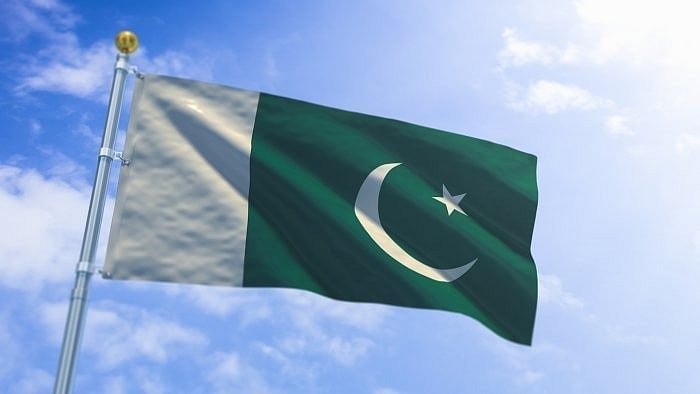
The Pakistan Flag.
Credit: iStock Photo
The Pahalgam terror attack was, inter alia, an attempt by the army-led Pakistani establishment to divert attention from its internal failures. Chief among them is the widespread unrest and lawlessness in Balochistan.
Constituting 44 per cent of Pakistan’s landmass but only around 6% of its population, Balochistan has witnessed five insurgencies since 1948. The fifth and ongoing insurgency began in 2005 after a female doctor accused an army officer of rape and gained momentum following the killing of prominent tribal leader Nawab Akbar Khan Bugti by the Pakistan army in 2006. It has continued with varying intensity. Notably, unlike previous insurgencies led by tribal sardars, the current movement has seen increasing participation by middle-class, educated youth. It is a nationalist movement untainted by the Islamic extremism that characterises most other armed groups active in Pakistan.
Besides the role of tribal sardars keen to guard their turf, unrest in Balochistan stems from three major factors.
The first is abject poverty and lack of development. Although resource-rich, Balochistan contributes only about 4.5% of Pakistan’s GDP. According to a study by the Pakistan Institute of Development Economics, the incidence of poverty in the province in 2019–20 was 70.5%, compared to 39.5% nationally. Youth unemployment in Balochistan has been reported at over 37%. The Punjabi-dominated federation has grossly exploited Balochistan’s resources with very little benefit to its people. For example, gas deposits in Pirkoh and Sui in Dera Bugti district have supplied gas to cities in Punjab since 1964, yet gas came to Dera Bugti only in the 1990s when a military camp was established there. The low gas price and the small percentage of royalties paid to the province have remained contentious issues.
Second, Balochistan figures prominently in China’s strategic designs due to its rich resources; as a maritime exit through the China–Pakistan Economic Corridor (CPEC), bypassing eastern choke points; and for the potential of the Makran coast to serve as a staging point for the Chinese navy in the Arabian Sea and the wider Indian Ocean. The Baloch view China as complicit in their exploitation. When China built the first phase of the Gwadar port two decades ago, only 30 out of 600 workers were locals. The Metallurgical Corporation of China (MCC) has operated the Saindak copper-gold mine in the Chagai district since 2002. The original contract allocated 50% of revenue to MCC, 48% to the federal government, and a mere 2% to Balochistan. This arrangement was repeatedly extended, and Balochistan’s current royalty is said to be 6.5%. It has been alleged that the Chinese have had a free hand in extracting resources without an independent audit of the copper and gold quantities involved. This has fuelled increasing attacks on Chinese nationals and interests by Baloch militants.
Third, all attempts by the Baloch to secure their political and economic rights have been crushed by the Pakistan army using brute force. There has been no sincere attempt to address their grievances through political dialogue.
Balochistan is strategically located along the Arabian Sea near the Strait of Hormuz, Iran, and Afghanistan. Pakistan reflexively and unjustifiably blames India for the turmoil. However, many other countries have an interest in the region. Some are concerned about Chinese ambitions in Balochistan. Others with successful ports in the Persian Gulf may view the potential rise of Gwadar and other Pakistani ports as a threat. Additionally, instability in Afghanistan and Iran’s Sistan and Baluchestan province spills over into Balochistan. Significantly, in 2012, then Interior Minister Rehman Malik informed Pakistan’s Senate that 14 foreign organisations were operating in Balochistan and that both “foes” and “friends” of Pakistan were involved in financing and fomenting the insurgency.
Paradoxically, the Taliban victory in Afghanistan, aided and abetted by Pakistan, has worsened Pakistan’s problems in Balochistan and its tribal belt. Pakistan alleges that Tehreek-e-Taliban Pakistan (TTP) and Baloch insurgent groups have been using Afghan territory to launch attacks against it — a claim flatly denied by the Taliban.
The fifth Baloch insurgency has taken a more ominous turn in recent years, marked by increasingly sophisticated and brutal attacks by pro-independence Baloch groups. In March, a train carrying 400 passengers, including several army personnel, was hijacked by the Baloch Liberation Army. The crisis lasted two days and resulted in multiple deaths. Smaller-scale attacks have continued periodically. The Global Terrorism Index 2025, published by the Institute for Economics and Peace, ranks Pakistan second only to Burkina Faso. A breakdown of state authority in large parts of Balochistan has been reported.
Each wave of intense violence in Balochistan has prompted predictions of its secession from Pakistan. A few factors are relevant in this context. Resentment against the state is most intense among the Baloch segment of the population. Pakistan’s census results do not list ethnicity, but population data by mother tongue released by the Pakistan Bureau of Statistics in 2017 indicated that 54.76% of Balochistan’s people speak Balochi and 29.64% speak Pashto, followed by smaller linguistic groups. The relatively small population of ethnic Baloch in this sparsely populated province has made it easier for the Pakistani state to suppress their aspirations.
Furthermore, while some recent attacks in Balochistan have been sensational, perspective is necessary. In the first decade of this century, Pakistan faced a far more intense wave of terrorism across the country, including in its Punjabi heartland. Key military installations, including the GHQ in Rawalpindi, were targeted. The country was then widely believed to be facing an existential threat, but it survived. Pakistan cannot continue to tempt fate indefinitely. While some countries may find it convenient to see Balochistan in turmoil, no major power has, so far, supported its secession.
It is clear that Balochistan will remain turbulent. However, drawing hasty conclusions about its separation from Pakistan would be premature.
(Sharat Sabharwal is a former High Commissioner to Pakistan and author of "India’s Pakistan Conundrum: Managing a Complex Relationship")